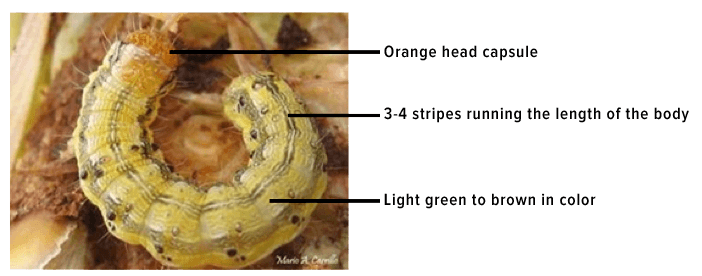Corn earworm (Helicoverpa zea) is found throughout North America except for northern Canada and Alaska. Normally, corn earworm does not overwinter successfully in the northeastern United States. It is known to survive as far north as about 40 degrees north latitude, or about Kansas, Ohio, Virginia, and southern New Jersey, depending on the severity of winter weather. In the relatively mild Pacific Northwest, corn earworm can overwinter as far north as southern Washington.
Losses in field corn have been estimated at 2.5% annually, with losses in the southern United States ranging from 1.5-16.7%. Losses in sweet corn may be as high as 50%. Between the difficulty of effectively controlling corn earworm with insecticides and the damage generally being overlooked until harvest, many farmers have elected to accept the lost yield potential.
Life Cycle
Egg laying occurs primarily in the evening hours, with each female capable of laying 500 to 2000 eggs during her 2-week life span. Eggs hatch in 3 to 4 days at an average temperature of 77° F. Larvae feed on whorl stage corn and other host plants for a period of 3 to 4 weeks before burrowing into the soil to pupate. Two full generations of earworm development can occur each year after the spring/summer migration into the area. Population densities usually peak in late summer.
Second generation larvae and moths occur during pollination when the moths lay eggs on the corn silks. Larvae migrate down the silks to the ear tips within 1 hour of hatching and feed on developing kernels under the protective husk for the entire larval stage. Even though moths may lay more than one egg per ear, there is generally only one larva per ear because they are cannibalistic. When larval development is complete, the larva chews through the husk and exits the ear. It then drops to the ground, burrows into the soil, and pupates.
Management
Planting early can help avoid peak moth flights, and corn with tight husks can help reduce feeding potential. Several foliar insecticides are labeled for control of corn earworm; however, the contact needed between larvae and foliar insecticides for good efficacy is rare due to larvae burrowing down the silks soon after hatching.
Sources:
1 Cook, K.A & Weinzierl, R. 2004. Corn Earworm Insect Fact Sheet. University of Illinois. http://ipm.illinois.edu/ (verified 3/11/2014)
2 Capinera, J.L. 2014. Featured Creatures. University of Flordia IFAS. http://entnemdept.ufl.edu/ (verified 3/11/2014)



